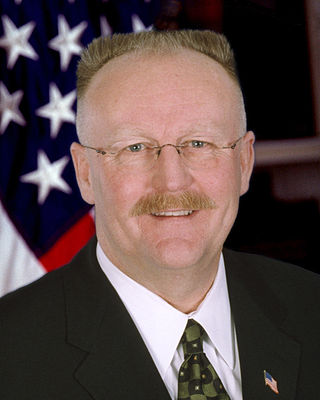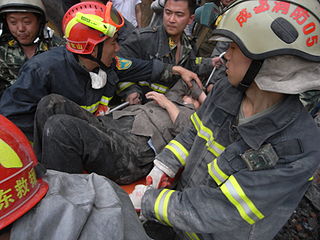Related Research Articles

In the United States, community emergency response team (CERT) can refer to
Continuity of Operations (COOP) is a United States federal government initiative, required by U.S. Presidential Policy Directive 40 (PPD-40), to ensure that agencies are able to continue performance of essential functions under a broad range of circumstances. PPD-40 specifies certain requirements for continuity plan development, including the requirement that all federal executive branch departments and agencies develop an integrated, overlapping continuity capability, that supports the eight National Essential Functions (NEFs) described in the document.

Federal Emergency Management Agency (FEMA) is an agency of the United States Department of Homeland Security (DHS), initially created under President Jimmy Carter by Presidential Reorganization Plan No. 3 of 1978 and implemented by two Executive Orders on April 1, 1979. The agency's primary purpose is to coordinate the response to a disaster that has occurred in the United States and that overwhelms the resources of local and state authorities. The governor of the state in which the disaster occurs must declare a state of emergency and formally request from the President that FEMA and the federal government respond to the disaster. The only exception to the state's gubernatorial declaration requirement occurs when an emergency or disaster takes place on federal property or to a federal asset—for example, the 1995 bombing of the Alfred P. Murrah Federal Building in Oklahoma City, Oklahoma, or the Space Shuttle Columbia in the 2003 return-flight disaster.
Enhanced 911 is a system used in North America to automatically provide the caller's location to 911 dispatchers. 911 is the universal emergency telephone number in the region. In the European Union, a similar system exists known as E112 and known as eCall when called by a vehicle.

The United States presidential line of succession is the order in which the vice president of the United States and other officers of the United States federal government assume the powers and duties of the U.S. presidency upon an elected president's death, resignation, removal from office, or incapacity.

The Mount Weather Emergency Operations Center is a government command facility in the U.S. Commonwealth of Virginia, used as the center of operations for the Federal Emergency Management Agency (FEMA). Also known as the High Point Special Facility (HPSF), its preferred designation since 1991 is "SF".

The Incident Command System (ICS) is a standardized approach to the command, control, and coordination of emergency response providing a common hierarchy within which responders from multiple agencies can be effective.
The nuclear football is a briefcase, the contents of which are to be used by the president of the United States to communicate and authorize a nuclear attack while away from fixed command centers, such as the White House Situation Room or the Presidential Emergency Operations Center. Functioning as a mobile hub in the strategic defense system of the United States, the football is carried by a military aide when the President is traveling.
The National Incident Management System (NIMS) is a standardized approach to incident management developed by the United States Department of Homeland Security. The program was established in March 2004, in response to Homeland Security Presidential Directive-5, issued by President George W. Bush. It is intended to facilitate coordination between all responders. The system has been revised once, in December 2008. NIMS is the common framework that integrates a wide range of capabilities to help achieve objectives.

Joe M. Allbaugh is an American political figure in the Republican Party. After spending most of his career in Oklahoma and Texas, Allbaugh came to national prominence working for Texas governor George W. Bush and helping manage his 2000 presidential election campaign. Allbaugh then became Bush's Director of the Federal Emergency Management Agency (FEMA) beginning in February 2001. He served until FEMA's transfer into the newly created Department of Homeland Security, after which he resigned in March 2003. He was appointed as the interim Director of the Oklahoma Department of Corrections by the state Board of Corrections, effective January 11, 2016. On July 6, 2016, the Oklahoma Board of Corrections voted unanimously to make his appointment permanent and set his salary at $185,000. Allbaugh has pointed out his department "is not a listing ship, it is a sinking ship."

The Robert T. Stafford Disaster Relief and Emergency Assistance Act is a 1988 United States federal law designed to bring an orderly and systematic means of federal natural disaster assistance for state and local governments in carrying out their responsibilities to aid citizens. Congress's intention was to encourage states and localities to develop comprehensive disaster preparedness plans, prepare for better intergovernmental coordination in the face of a disaster, encourage the use of insurance coverage, and provide federal assistance programs for losses due to a disaster.

Urban search and rescue is a type of technical rescue operation that involves the location, extrication, and initial medical stabilization of victims trapped in an urban area, namely structural collapse due to natural disasters, war, terrorism or accidents, mines and collapsed trenches.
An order, line or right of succession is the line of individuals necessitated to hold a high office when it becomes vacated, such as head of state or an honour such as a title of nobility. This sequence may be regulated through descent or by statute.

Mark V. Cerney is the founder of an American nonprofit organization. He is best known for creating the Next of Kin Registry (NOKR) model.
Presidential Decision Directive 62 (PDD-62), titled Combating Terrorism, was a Presidential Decision Directive (PDD), signed on May 22, 1998 by President Bill Clinton. It identified the fight against terrorism a top national security priority.

Wireless Emergency Alerts, is an alerting network in the United States designed to disseminate emergency alerts to mobile devices such as cell phones and pagers. Organizations are able to disseminate and coordinate emergency alerts and warning messages through WEA and other public systems by means of the Integrated Public Alert and Warning System.
The Integrated Public Alert and Warning System (IPAWS) is an architecture that unifies the United States' Emergency Alert System, National Warning System, Wireless Emergency Alerts, and NOAA Weather Radio, under a single platform. IPAWS was designed to modernize these systems by enabling alerts to be aggregated over a network and distributed to the appropriate system for public dissemination.

National Response Scenario Number One is the United States federal government's planned response to a small scale nuclear attack. It is one of the National Response Scenarios developed by the United States Department of Homeland Security, considered the most likely of fifteen emergency scenarios to impact the United States. The Scenarios are related to the National Response Framework (NRF), which describes the structures and mechanisms of a response and the National Incident Management System (NIMS) that gives a framework to orchestrate emergency management. The scenario anticipates terrorists detonating a single, 10 kiloton weapon in a major city, as opposed to a full-scale nuclear war, in which a foreign power such as Russia or China would detonate hundreds or thousands of weapons.
COGCON is a United States government readiness level, roughly analogous to the DEFCON alert state system, tracking the readiness of the government in the event of an emergency.
Presidential Emergency Action Documents (PEADs) are draft classified executive orders, proclamations, and messages to Congress that are prepared for the President of the United States to exercise or expand powers in anticipation of a range of emergency hypothetical worst-case scenarios, so that they are ready to sign and put into effect the moment one of those scenarios comes to pass. They are defined by the Federal Emergency Management Agency as the "Final drafts of Presidential messages, proposed legislation proclamations, and other formal documents, including DOJ-issued cover sheets addressed to the President, to be issued in event of a Presidentially-declared national emergency."
References
- 1 2 3 FEMA Transition Binder (PDF). Federal Emergency Management Agency. 2009. p. 88.
- 1 2 Mohr, Charles (June 29, 1982). "Preserving U.S. Command After a Nuclear Attack". The New York Times . Retrieved August 1, 2017.
- 1 2 Graff, Garrett (2017). Raven Rock: The Story of the U.S. Government's Secret Plan to Save Itself. Simon and Schuster. ISBN 9781476735450.
- 1 2 3 Graff, Garrett (September 21, 2016). "Who's In Charge of America After a Catastrophe? Who Knows?". Politico . Retrieved August 1, 2017.
- 1 2 3 4 "COMMUNICATIONS HANDBOOK FOR CENTRAL LOCATOR SYSTEM" (PDF). National Archives and Records Administration. White House Communications Agency. Retrieved August 1, 2017.